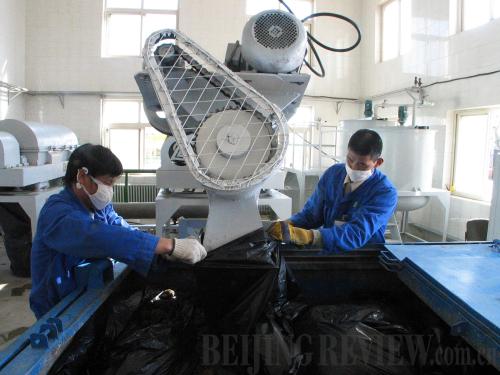|
 |
|
RECOVERING RESOURCES: Workers bag solid organic fertilizer at a biological treatment plant in Fengtai District, Beijing. The plant turns 400 tons of manure into solid organic fertilizer daily (DENG JIA/CFP) |
Beijing has 13 landfills, with a designed daily capacity of 10,400 tons. But on a single day last year, 17,400 tons of waste was treated, with 1,000 tons left unprocessed on a daily basis.
There is a large landfill in Liulitun, Beijing's Haidian District, which is dozens of meters deep and is as large as about a dozen football fields. It was built in 1999 with a designed daily capacity of 1,500 tons. It was expected to reach capacity in 2017, but at its current rate of use, the facility will be filled and closed next year. Some experts said Beijing would have no more room for trash in four to five years.
In many Chinese cities, there is too much trash to be treated. Government statistics show that last year about 40 percent of waste did not go through centralized treatment because processing costs were too high. Some untreated waste is simply transported and dumped in the suburbs or countryside.
An alternative to landfills is waste incineration. This treatment technology seems simple and quick, reducing trash volume by at least 50 to 80 percent. The energy produced in the combustion process can be harnessed for electricity and heating.
But waste incineration releases toxic compounds like dioxin, which is 130 times as damaging as cyanide and 900 times as toxic as arsenic trioxide. The International Agency for Research on Cancer has listed dioxin as carcinogenic to humans.
Nonetheless, experts like Wang are very confident that the right technology can keep the amount of emitted dioxin at safe levels. Wang said that one way to remove the chemical is to control the combustion temperature.
China has built waste incinerating plants in recent years and some have been successful, said Wu Xiaoqing, Vice Minister of Environmental Protection. He said his ministry had worked with other agencies in 2008 and clarified management and technical requirements. Wu emphasized that waste-incinerating plants need to be strictly regulated.
But experts realize the optimal waste treatment strategy was to reduce the production of garbage, said Wang. Mao Da, a doctoral student majoring in environmental history at Beijing Normal University, said waste management should follow the 3 "Rs"—reduce, reuse and recycle—the amount of trash should be reduced first of all.
Reduce
Every 500 grams of moon cake were wrapped in 2,000 grams of packaging, a Mid-Autumn Festival survey revealed. The study, conducted by Lu Ming, a School of Environment and Natural Resources professor at the Renmin University of China, showed product packaging has created a large amount of waste.
On November 2-10, the Beijing Municipal Cityscape Management Commission solicited public feedback for its tentative "zero waste" methods and standards, which encourages trash reduction and proper garbage sorting. For instance, government organizations will be required to: purchase environmentally friendly, recyclable and energy-saving products; print on both sides of office paper; and not provide any single-use tableware in workplace canteens.
Reuse
Reusing products destined for the trash heap is the most effective way to deal with garbage and represents the future of waste management, said Zhao Zhangyuan, a research fellow with the Chinese Research Academy on Environmental Sciences. In experts' eyes, Zhao said, garbage is a misplaced resource that can be converted into new resources if properly treated.
Research has shown that China loses 25-30 billion yuan ($3.7-$4.4 billion) in trash resources and, if garbage is sorted and reused, the country could generate production value exceeding 250 billion yuan ($37 billion) each year.
Some firms are recycling and reusing trash. In Beijing's Shangdi area, vehicles collect leftovers from restaurants and transport them to waste treatment stations equipped with microbial recycling technology invented by Beijing Goldenway Biology Tech Co. Ltd. After eight hours of high-temperature fermentation, kitchen waste produces 0.6 tons of microbial communities, which can be used to produce fodder and fertilizer.
Incom Resources Recovery Co. Ltd. plants are turning plastic Coca-Cola bottles back into nontoxic base materials, which can be reconverted into beverage bottles or weaved into clothes, bags or caps. This June, a delegation of German business people and environmental managers came to China to attend a China-Germany environment forum and visited the plants. They saw how used bottles were being transformed into new ones. About six used bottles can make a T-shirt that is 85 percent polyester, and 100 used bottles can produce 80 new ones. China currently produces 3 million tons of plastic bottles each year and consumes more than 18 million tons of oil. Reusing waste will not only cut pollution from landfills and waste incinerators, but will also save oil.
In Beijing, there are also companies that specialize in turning waste plastics, wood and crop residues into construction materials. Demolished construction materials can be reprocessed into new ones, and the recycling rate can reach 100 percent. | 